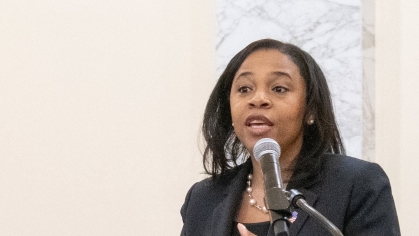SPAA Professors Suzanne Piotrowski and Gregory Porumbescu Actively Promote Public Sector Transparency and Governance Through Center
Established in 2012, the Transparency and Governance Center (TGC) in the School of Public Affairs and Administration (SPAA) examines public sector transparency and governance through its research, projects, programs, and global network of scholars. We sat down with SPAA Associate Professor and TGC Director Suzanne Piotrowski and SPAA Assistant Professor and TGC Associate Director Gregory Porumbescu to discuss the center's work and their vision for how their research will impact public sector transparency and the field of public administration.
What do you identify as the center’s primary purpose?
SP: The purpose of the Transparency and Governance Center is to better understand the impact of transparency on good governance. We do this through academic and applied research projects, educational outreach, and networking with otherscholars. The center was created to focus and amplify the work in this area that was already being done. We want to create opportunities for people to work together so that our work is greater than the sum of its parts.
We think of ourselves as a hub for different scholars – we’ve hosted a number of scholars from a wide range of countries including the Netherlands, Portugal, Switzerland, and Italy. A strength of the center is that we are multidisciplinary. We have several affiliated faculty members from around campus.
What are some of the center’s current projects?
GP: Our recent projects include ones on the effects of data portals on health behaviors, the relationship between the Freedom of Information Act and trust in government, the impact of the open government reform movement on FOIA, and an analysis of the Open Government Partnership.
Our new projects assess transparency from two perspectives: accessibility of information and usability of information. For the public, transparency is only transformative if the public is able to understand the information being disseminated. With that in mind, we are looking at different methods to communicate information in ways that are easier for citizens to understand. We’re kicking off a project to collaborate with government actors and public officials to explore methods of improving the usability of information that’s being made public. In terms of next steps, we want to work more closely with government agencies, especially in Newark and New Jersey, to explore ways of improving understandability and making sure that everyone has access.
SP: We’re going to start developing some courses for the classroom, as well as workshops to teach individuals how to access and use government information.
It’s a new project but we see a lot of need, and it can really bridge our academic work with applied work and have a real impact on residents in the communities SPAA serves.
How does the center’s work transform public administration as a field?
SP: When we approach our work, we consider the United Nations Sustainable Development Goals, specifically Sustainable Development Goal 16, which talks about ensuring public access to information. We’re thinking about ways we can move things forward in ensuring access to public information in both applied research projects and academic research. We think this has a real impact in the public sphere and in addition to our research, we try to move the field forward through our networking. We have the International Transparency and Secrecy Research Network that’s very active and has more than 450 members. I founded the Global Conference on Transparency Research and currently chair its executive committee. The center hosts transparency workshops at SPAA. We try to bring people together to present their research and hope these synergies make impact on the field at large.
What do you think are the most significant issues and threats regarding public transparency at the moment?
GP: As researchers in the field, we want to unpack the concept of transparency so policymakers can be better informed. Taking a critical look at the concept of transparency in research and practice and trying to figure the linkages between transparency and other key governance issues like trust, corruption, and good management are significant issues. People tend to assume that there are positive relationships between these concepts, but the evidence is mixed at best. This checkered evidence indicates that we, as researchers, really need to dig deeper to understand what it is that transparency can bring to the table, what transparency does in practice, and what its value is.
To improve our understanding of transparency, there are really two key perspectives we need to cultivate to deepen our understanding of the value of transparency. The first is an academic perspective and the biggest challenge is a lack of theoretical frameworks that do a good job of explaining transparency and why governments decide to become transparent in different ways as well as a lack of theory explaining the contours of the relationship between transparency and good governance.
Second, from a more applied perspective, the biggest challenge is that transparency can actually reinforce status quos in a democratic way, in that some people become complacent if information is hard to find and understand, and then they lose control of their government – essentially the government becomes less accountable to them. So the challenge is making information useful and we lack research on this.
From an international perspective, how transparent is the U.S. federal government compared to other countries?
SP: I would say the United States is innovative in some areas and lagging in others. In particular, some of the work being done on citizen science projects in the United States is really interesting and progressive and the use of technologies to help with access to information in the United States is forward-looking, but there are lots of other areas, basic areas, that need some work, like with data quality, archiving documents, and declassifying documents. Those are some of the core aspects of transparency that could definitely use some improvement.
What are some areas of the government where you think there’s a greater need for transparency?
SP: Some of the global trends that I think the United States needs to catch up on is in respect to beneficial ownership, in terms of who owns companies and who is benefiting financially from companies. Also, in terms of natural resources, the government could do a better job with respect to creating openness around who is benefitting from natural resources taken off of public lands.
GP: I think that’s accurate, but for different people there are general areas in which transparency can be improved and different segments of the population will need different types of information. In other words, it is about finding out the information that’s needed to empower certain segments of society because the value of information isn’t absolute, it varies. In this sense, in addition to Suzanne’s comments, the need for greater transparency will vary across groups of citizens.


